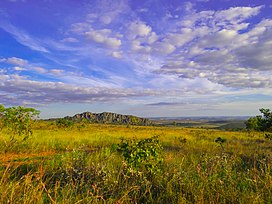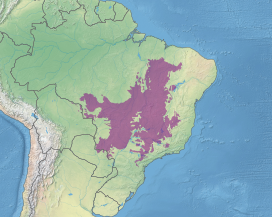
Back سيرادو Arabic Ecorrexón del Cerrado AST Серадо Bulgarian Cerrado Catalan Cerrado Czech Cerrado Danish Cerrado German Cerado Esperanto Ecorregión del Cerrado Spanish Cerrado ekoeskualde Basque
| Cerrado | |
|---|---|
 Vegetation in Pirineus State Park, Goiás | |
 Map of the Cerrado ecoregion as delineated by the World Wide Fund for Nature. | |
| Ecology | |
| Realm | Neotropical |
| Biome | tropical and subtropical grasslands, savannas, and shrublands |
| Borders | |
| Geography | |
| Area | 1,910,037 km2 (737,469 sq mi) |
| Countries | |
| Conservation | |
| Conservation status | Vulnerable |
| Global 200 | Cerrado woodlands and savannas |
| Protected | 433,581 km2 (23%)[1] |
The Cerrado (Portuguese pronunciation: [seˈʁadu]) is a vast ecoregion of tropical savanna in eastern Brazil, being present in the states of Goiás, Mato Grosso do Sul, Mato Grosso, Tocantins, Maranhão, Piauí, Bahia, Minas Gerais, São Paulo, Paraná and the Federal District. The core areas of the Cerrado biome are the Brazilian highlands – the Planalto. The main habitat types of the Cerrado consist of forest savanna, wooded savanna, park savanna and gramineous-woody savanna. The Cerrado also includes savanna wetlands and gallery forests.[2]
The second largest of Brazil's major habitat types, after the Amazonian rainforest, the Cerrado accounts for a full 21 percent of the country's land area (extending marginally into Paraguay and Bolivia).[3] About 75% of the Cerrado’s 2 million km2 is privately owned.[4]
Vast amounts of research have shown that the Cerrado is one of the richest of all tropical savanna regions and has high levels of endemism. Characterizing it by its enormous ranges of plant and animal biodiversity, World Wide Fund for Nature named the Cerrado the biologically richest savanna in the world, with about 10,000 plant species and 10 endemic bird species.[3] There are nearly 200 species of mammal in the Cerrado, though only 14 are endemic.[3] The large fraction of private ownership makes protection difficult though.[4]
- ^ Dinerstein, Eric; Olson, David; et al. (June 2017). "An ecoregion-based approach to protecting half the terrestrial realm". BioScience. 67 (6): 534–545, Supplemental material 2 table S1b. doi:10.1093/biosci/bix014. PMC 5451287. PMID 28608869.
- ^ Vasconcelos, Vitor Vieira; Vasconcelos, Caio Vieira & Vasconcelos, Davi Mourão (2010). Phyto-Environmental Characterization of Brazilian Savanna (Cerrado) and Brazilian Atlantic Forest, with the Research of Stone Lines and Paleosols (Report). Geografia. Vol. 14. Translated by Vasconcelos, Vitor Vieira. Brazil: Ensino & Pesquisa (UFSM). p. 3. Retrieved 6 October 2022 – via pt.scribd.com.
- The report, above, is a translation of the original publication:
- The report, above, is a translation of the original publication:
- ^ a b c "Overview". BiodiversityHotspots.org. Cerrado. Conservation International. Archived from the original on 6 May 2008. Retrieved 9 May 2008.
- ^ a b Machado, Ricardo B.; Aguiar, Ludmilla M. S. (21 April 2023). "Could you spare an acre for conservation?". Science. 380 (6642): 238–239. Bibcode:2023Sci...380..238M. doi:10.1126/science.adh1840. ISSN 0036-8075. PMID 37079692. S2CID 258258769.